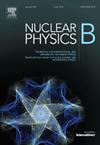基于Noether对称和Eisenhart-Duval升力的非最小耦合理论中的标量场动力学
IF 2.5
3区 物理与天体物理
Q2 PHYSICS, PARTICLES & FIELDS
引用次数: 0
摘要
本文研究了修正重力下非最小耦合(NMC)标量场的动力学,采用诺特规范对称(NGS)方法系统地推导出精确的宇宙学解。通过建立类点拉格朗日方程并分析相应的欧拉-拉格朗日方程,确定了守恒量,降低了动力系统的复杂性。通过应用诺特对称原理,发现标量场势遵循幂律形式,明确地依赖于耦合参数ξ,影响宇宙的演化。该研究进一步探索了暴胀动力学,表明对于特定值ξ,势类似于希格斯结构,有助于更深入地了解早期宇宙膨胀。为了加强理论框架,引入了Eisenhart举升方法,通过在扩展的场空间中嵌入动态变量来提供系统的几何解释。这种方法建立了动力学项和杀伤矢量之间的联系,为守恒量提供了另一种视角。该研究还推导出了控制系统演化的测地线方程,加强了基于对称的技术与基本宇宙学特性之间的联系。本文章由计算机程序翻译,如有差异,请以英文原文为准。
Scalar field dynamics in non-minimally coupled theories via the Noether symmetry and the Eisenhart-Duval lift
This study investigates the dynamics of a non-minimally coupled (NMC) scalar field in modified gravity, employing the Noether gauge symmetry (NGS) approach to systematically derive exact cosmological solutions. By formulating a point-like Lagrangian and analyzing the corresponding Euler–Lagrange equations, conserved quantities were identified, reducing the complexity of the dynamical system. Through the application of Noether symmetry principles, the scalar field potential was found to follow a power-law form, explicitly dependent on the coupling parameter ξ, influencing the evolution of the universe. The study further explores inflationary dynamics, showing that for specific values of ξ, the potential resembles the Higgs-like structure, contributing to a deeper understanding of early cosmic expansion. To enhance the theoretical framework, the Eisenhart lift method was introduced, providing a geometric interpretation of the system by embedding the dynamical variables within an extended field space. This approach established a connection between the kinetic terms and Killing vectors, offering an alternative perspective on the conserved quantities. The study also derived geodesic equations governing the evolution of the system, reinforcing the link between symmetry-based techniques and fundamental cosmological properties.
求助全文
通过发布文献求助,成功后即可免费获取论文全文。
去求助
来源期刊

Nuclear Physics B
物理-物理:粒子与场物理
CiteScore
5.50
自引率
7.10%
发文量
302
审稿时长
1 months
期刊介绍:
Nuclear Physics B focuses on the domain of high energy physics, quantum field theory, statistical systems, and mathematical physics, and includes four main sections: high energy physics - phenomenology, high energy physics - theory, high energy physics - experiment, and quantum field theory, statistical systems, and mathematical physics. The emphasis is on original research papers (Frontiers Articles or Full Length Articles), but Review Articles are also welcome.
 求助内容:
求助内容: 应助结果提醒方式:
应助结果提醒方式:


